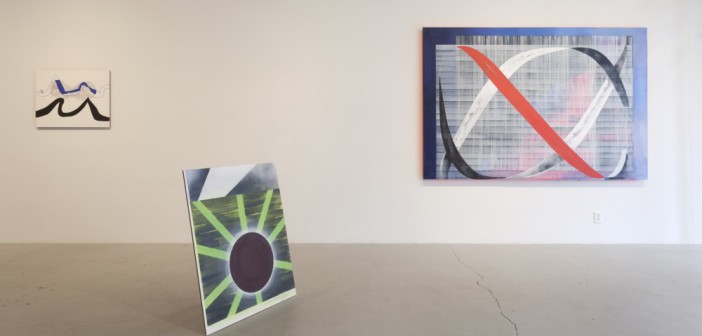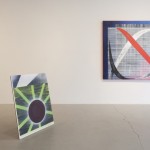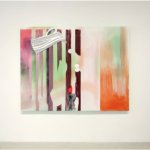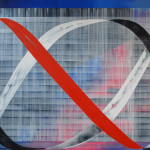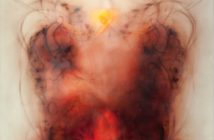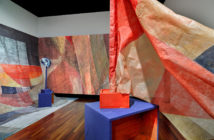Sometimes, after leaving a show, I feel a tinge of regret in the pit of my stomach. The regret stems from the feeling that there was only so much I was able to grasp of the work; that there’s more for me there than I was able to pick-up on within the window of time allotted. I am only able to access visual information in accordance with the way I’m thinking about things in my own life at the moment of viewing. I know this seems like a silly qualm to have, and I tell myself that I should just revel in what I do take in. I remember being a child and wishing I could hop into the reality of a painting instead of just being the beholder, which seemed restrictive and limiting. What I really enjoyed about seeing Sonia Almeida’s show The Event We Call Seeing (at Simone Subal Gallery in Manhattan through December 21) is the delicate, playful and focused way in which the artist handles this quality in art viewing. Almeida is playing with the way we take in visual information currently, and I might go so far as to say as she’s poking fun of the fact that contemporary viewers are generally over-stimulated, and that we can only truly grasp so much information at once.
I currently work in Midtown, and just walking down the street here at first was a big experience in itself: my co-worker likes to say it’s like being in a "sea of humanity". There’s also the array of massive billboards and giant screens with ads.I could go on, and on, about how much information overload is going on just in Midtown Manhattan. What has caused some to be ill at ease doesn’t affect me anymore. My body has built up some way of coping that I don’t understand, and now it’s just part of how I respond, how I experience. The brilliance in Almeida’s work is that it harnesses this new way of experiencing, rather than rejecting it. It works with the way our culture sees now, and for a room of paintings to do that seems like a giant feat to me.
Threaded through the show is a questioning of the screen as an idea; flowing, gestural forms duck in and out of painterly washes of transparent color. Walking through the show, one gets the feeling of being a key player in a game of hide and go seek with form itself. That which is seen becomes equally important as what is unseen. Hot colors excite the senses on a visceral level, which is then followed by an unexpected cooling off of sense as we try to mentally comprehend what we are seeing, as we attempt to fit it into our narrow capacity of understanding. This "on and off" mechanism is not only suggested but is illustrated in paintings such as Forward/Play/Pause (2013) which incorporates the play and stop button into the composition. This use of icons borrowed from our interactions with technology points to the tragic artifice that makes up much of our lives today, as well as the idea that utilizing these tools will instill within us a false or temporary sense that we have ultimate control over our experience. If only we could push play or stop in our lives when we feel too overwhelmed, too bogged down, or whatever.
The way Almeida utilizes the space of the gallery invites us to be all over the place, in the way that we most often already are. Paintings are displayed leaning on floor supports to redirect our point of focus; it’s as if the artist is saying "Look here! Look there!"and pointing with furious excitement. She incorporates the use of LED lights behind a few of the paintings, which gives the effect of a glowing presence in the room, and also works with the idea that there’s more to be shown than we are capable of knowing about. Almeida’s interest in toying with our attention is inherent both in the imagery and the display of the work. What’s notable here is the ability to make that search for the subject become the subject.
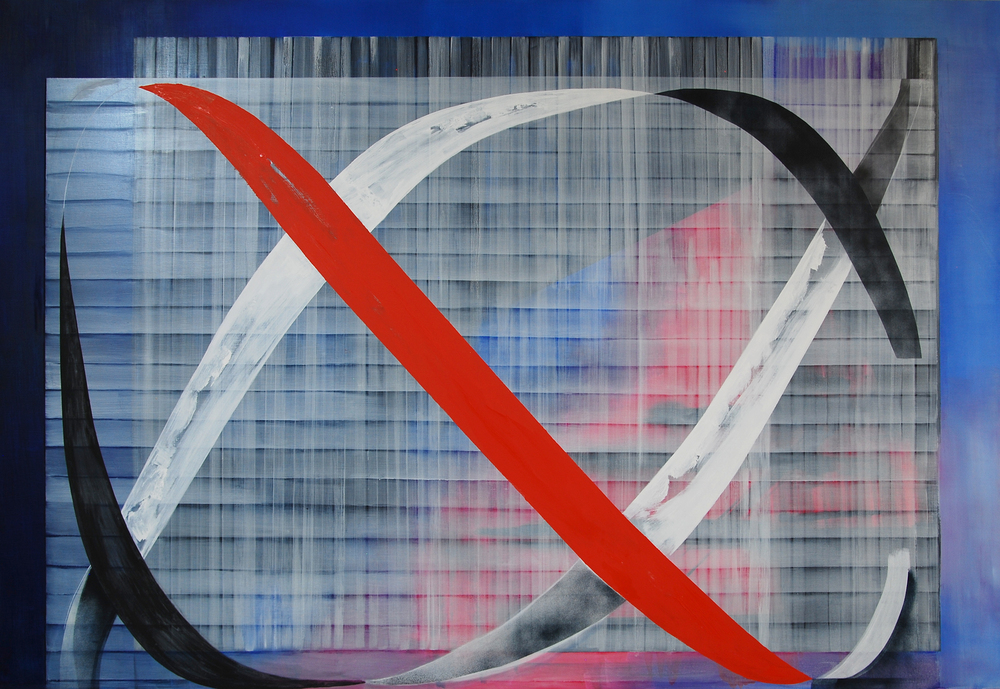
Sonia Almeida
Red Signal 2013
In this work, Almedia exhibits a real sensitivity and ownership of the use of gesture. Almeida’s natural way of working seems to be rooted in allowing the interaction of the mark and the materials to stand on its own. There is a delicate balance of restraint coupled with a loose, bodily oriented interaction. Works such as Red Signal (2013) live within the realm of that balancing act. A form appearing as a large infinity sign, or double helix, swoops across a large canvas in bold, saturated color and fights to remain the focus of the work even though we are equally intrigued by the layers of washy white behind it. An almost grid-like structure lies beneath what claims to be most visually apparent in the painting, yet there is a hint of something being formed there. There is a suggestion of something occurring behind the painterly screens that is more compelling than the bold, gestural form taking center stage. This shifting of our focus is Almeida’s forte, and the ability she has to make us question what we believe we are seeing is awe-inspiring. Formally, I was reminded of action painting from the 1960s as well as the great gestural modernists. While Almeida visits in their territory, this work remains in its own distinct realm wherein we, as the observers, are also collaborators. Further, our interaction within the space imbues meaning and power.
Almeida’s imagery references the way we piece together memories as well as consciousness itself. In The Event We Call Seeing we are being shown fragmentary bits of something much larger in each piece, which is similar to the way we process things within our world. Blue Wavelength (2013) is a painting that delves into this dilemma. Two squiggly, intestine-like forms float across the canvas as if suspended in air; one bold and stark black and the other a semi filled in blue, interacting with a gray, washy shape and frantic little marks of pink. In allowing overlaps and unexpected interactions between paint languages, Almeida is not condemning us for having trouble focusing, but rather celebrating what could be viewed as a negative attribute.
I thought a lot about seeing for days after seeing the show. Whenever we see something in the world, we assign meaning to it. Often that meaning is derived from what we already feel we know, or from what our experience has thus far dictated to us. This makes us feel safe, but so much more is opened up when we find ourselves in that place of non-knowing; when we don’t have a reference point to attach to the visible and are invited to just see. In life our greatest wisdom comes when we are operating from that blind spot, when we are untethered, unchained to belief systems and thought patterns which do not serve us. All clutching and controlling that we employ comes from that tendency to put things in boxes, and trying to use what we feel we know as a means to make sense of what is happening around us. But as we go forward into the unknown, we have the power to go beyond ourselves. In this work, reverence is paid to the event of seeing now- not later, not before. I found myself in that territory as I took in Almeida’s work. I allowed myself to be the seer, the empty vessel that invites experience to flow through the body. I hope to find myself there again and again, and not just in the context of a gallery.
- Installation Shot (from l to r): Blue Wavelength, Brown Sun Eclipse, and Red Signal Image courtesy Simone Subal Gallery
- Sonia Almeida Silver Screen 2013 Oil on marine plywood and green LED’s 64 x 82 “
- Sonia Almeida Red Signal 2013
Sonia Almeida, The Event We Call Seeing was on view at Simone Subal Gallery in New York City through December 21, 2013,
For more information, visit the gallery's website.

